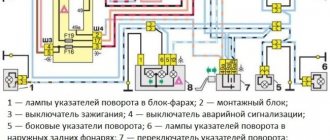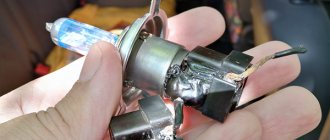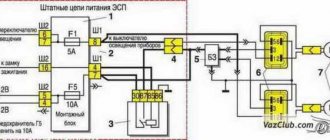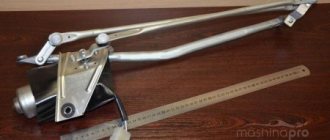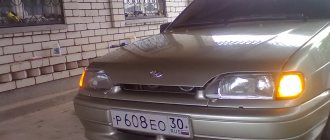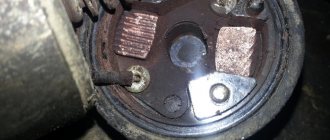Checking the serviceability of the turn relay.
First, make sure that the measuring instruments and control lamps on the instrument panel are working.
If they do not work, then check the fuse. If the devices are working properly, turn on the hazard warning button and check that all the lamps in the direction indicators are blinking. This will allow you to divide the circuit into two parts and speed up troubleshooting. If the alarm does not work when turned on, then it is necessary to check the serviceability of the turn and alarm relay and the presence of power at its terminal 49. The pin designation is marked on the bottom of the relay, next to the contact legs.
We remove the relay, which is marked in the form of a triangle on the top of the case, from the mounting block, and in the vacated socket, using a test paw, check for the presence of a plus on pin 49. We connect the test lamp to the ground or minus of the battery, and with the other end we touch pin 49, when If the hazard warning button is on, you do not need to turn on the ignition. Lack of power indicates a faulty fuse, alarm button or broken wires, contact tracks of the mounting block and poor contact in the connectors.
If there is a plus on the terminal, then connect terminals 49 and 49A with a copper wire. If the connecting wires and connectors are in good condition, all the direction indicator lamps should light up. This indicates that the turn signal and light signaling relay is faulty.
If the lamps do not light up, but there is a plus on pin 49, then there may be a short circuit in the signal lamp circuit and the fuse has blown. A short circuit can also cause the relay to fail. In this case, check the serviceability of the fuse, and if it blows, eliminate the short circuit in the signal lamp circuit.
Checking technical fault
The specified procedure is carried out every 2-3 months, regardless of the technical condition of the VAZ turn signal
First of all, attention is drawn to power wire No. 3, which is red. It comes from the positive terminal of the battery
The VAZ turn signals receive the electrical energy required for operation only when the ignition system is turned on. The procedure for performing a check is as follows:
If any of the above actions could not be completed, this indicates a technical malfunction. It is recommended not to delay in resolving the problem. Continued operation of the 2110 with a malfunctioning turning system increases the likelihood of an accident.
A loose connection or broken light bulb is a common cause of the dashboard light blinking too frequently. You can verify this visually. If the VAZ turn signal works in normal mode, then the problem is hidden precisely in the broken contact of the 2 elements. In second place in terms of frequency of occurrence is a faulty relay.
A sign of this problem is the prolonged or absence of burning of the VAZ-2110 turn lamps. The problem is caused by one of the following reasons:
This also includes a short circuit in the relay.
Checking the hazard warning button.
If the hazard warning lights are working, then the turn signal and hazard warning relays are working properly, but the fault may be in the hazard warning light button. First, check the plus, as described earlier at pin 49 of the relay, with the hazard warning button off and the ignition on.
If there is no plus, then you need to check the serviceability of the alarm button. To do this, you need to remove the button from the socket by prying it off with a thin screwdriver or remove the instrument panel visor. In the contact connector of the button, use a test lamp to check the presence of power at pin 2 (the numbering of pins on the button near the contacts) with the ignition on.
If there is no power, repair the broken wire from the instrument panel to the button. If there is power, connect pin 2 to pin 5 in the button socket, with the ignition on, and turn on the direction indicators of either side. If the warning lights on this board light up, replace the faulty hazard warning button.
If the warning lights do not light up, then, without removing the jumper from the hazard warning button block, connect pins 49 and 49A with a copper wire in the relay socket, then check the power at pin 49A of the turn switch. To do this, remove the steering column cover and the connecting connector from the turn switch. You can also remove the switch itself to determine the pin numbers that are marked on its lower part next to the contact legs.
This is not difficult to do by squeezing the latches on the sides of the switch and pulling it to the side. If the circuit from the relay to the switch is in good condition, the indicator lamp will start to light. If the control lamp does not light, then repair the break in the wire from the mounting block to the turn signal connector.
Self-diagnosis of car lighting devices
There are several situations in which you can determine that optics need diagnostics:
- The turns do not flash, but light up. Such a malfunction indicates the failure of the relay, in particular, we are talking about its electromagnetic component. The electromagnet itself could close in one of the positions, as a result of which it cannot return to its initial state.
- The turning lights flash very quickly or very slowly. In this case, the problem may lie not only in the relay. In some cases, this type of malfunction occurs when the driver uses inappropriate lighting sources. So when purchasing new light bulbs, you need to make sure that they correspond to the rating set by the car manufacturer.
- The optics don't work at all. That is, the turning light bulbs do not flicker, and the corresponding indicators on the dashboard also do not light up. In addition, there are no characteristic clicks that appear when turning on the turning lights. With such symptoms, there can be many reasons for the problem; we will tell you more about their diagnosis below (the author of the video is the Steel Horse channel).
As for diagnostics, it is performed in several stages:
- First of all, you need to make sure that all sensors and indicators on the device are working. If they do not function, then it is necessary to diagnose the safety devices.
- If all devices are operating in normal mode, then you next need to turn on the light alarm button and diagnose all light sources in the headlights. That is, check the front, rear, and side (if any) lights.
- If the alarm does not function when activated, you need to check the functionality of the relay, and also check the power supply at the terminals. To do this, remove the relay from its mounting location, and then, using a test light, connect one of its contacts to the installation site (to the positive), and the other to the car body or battery. There is no need to turn on the ignition. If there is no power, then most likely the reason lies in a failed safety device, a broken hazard warning button, or a damaged electrical circuit. Also, the essence of the problem may lie in poor contact in the connecting plugs.
- If there is a plus on the contacts, then try shorting the two relay terminals using copper wiring. If all electrical circuits, as well as the connection plugs, are working properly, then all turn signals should light up. In this case, the fault must be looked for in the relay.
- If the lights do not light up after the steps you have performed, then most likely the cause of the malfunction lies in the emergency light control button. However, in practice this happens quite rarely; there is often a short circuit in the circuit. By the way, it is a short circuit that can lead to a breakdown of the relay, therefore, before replacing the failed element, you need to eliminate the short circuit.
- If the emergency signal is functioning, this indicates that the safety devices and relays are working; accordingly, you need to start diagnosing the button itself. First of all, you need to diagnose the positive terminal, as in the case of checking the relay, while the ignition, as well as the hazard warning button, must be activated. If the diagnostics showed that there is no plus, this indicates that the button itself needs to be checked in more detail. Remove it from its seat and check the connection circuit. If there is no power, then you need to look for a break in the wiring from the tidy to the button itself. If there is power, then it will be necessary to short-circuit the terminals at the installation site, the ignition does not turn off, after which the direction indicators must be activated (on either side). When the lighting sources are turned on, the control button must be replaced, but if there is no power, then you need to check the power in the emergency relay. If there is no power, the problem most likely lies in a break in the connecting electrical circuit from the control key to the block with safety devices.
When turning on the turns, the fuse blows.
Another malfunction of the direction indicators is the fuse blowing when the indicators of one of the sides are turned on. To quickly identify a malfunction, turn on the hazard warning lights. The signal lamp in a circuit that has a short circuit will not light up or will burn at full intensity. A sign of a short circuit in the signal lamp circuit can be a buzzing sound from the turn signal relay when the indicators are turned on. To facilitate troubleshooting when the VAZ direction indicators do not work, use the diagrams below.
Turn signals and emergency lights in combination on a VAZ-2110
When operating a car, its owner may encounter various system malfunctions, including failure of turn signals to work. They may either not turn on or not turn off. There are different reasons.
Verification algorithm
- All lamps. If one lamp does not work, check it and the wires suitable for it. In rear turn signals, the printed tape and connector often “moody”.
- Fuse F16 or F19.
- Relay.
- Mass on turn signals.
- Understeering's shifter.
The steering column switch is checked by checking the contacts.
- Wiring.
Source
Turn signals do not work on VAZ 2112
If you look at the electrical diagram of the direction indicators of the VAZ-2112 passenger car, it is not difficult to guess that it is interconnected with the alarm circuit. These two systems have one common relay K3, located in the mounting block. It is significantly larger in size compared to other nearby relays. Also, these electrical circuits have one common 10-amp fuse F16. The reason for the failure of the direction indicators to work may be the burnout of one of the three lamps installed on the right or left side of the car. The driver is warned about the presence of such a malfunction by a warning light on the instrument panel that stops blinking. When replacing a burnt-out lamp, be sure to install a new lamp of the same power.
The turn signals will not work if relay K3 fails. This malfunction, in principle, can be determined by ear, since when the lever under the steering switch is moved to one of the on positions, the inoperative relay K3 will not emit characteristic clicks, which are heard only when a short circuit is made within its contacts. When replacing a failed relay, it is advisable to install exactly the same one that is installed at the VAZ automobile plant. Its marking is 145P, and relays marked up to 100P are counterfeit and they may be immediately faulty or their service life will be very short.
More complex malfunctions of the direction indicators of a VAZ-2112 car are also possible. One such case is when the turn signal lamps turn on dimly when they are turned on. This can lead to the fact that on a bright sunny day, when they are turned on, they will not be visible to other road users, which can create an emergency situation or even lead to an accident.
This malfunction is associated with a decrease in voltage at the terminals of the lamps, as a result of which their filament does not heat up to the required temperature. And you will have to look for this malfunction in the mounting block. To do this, you will have to remove and disassemble it, and then carefully inspect one of the jumpers on the board going to connector Ш3. Due to the fact that this jumper is small in size, and through it voltage is supplied to a large number of consumers, which leads to a voltage drop at the terminals of the direction indicator lamps when they are turned on. To eliminate this problem, you need to duplicate this jumper by soldering an additional copper wire.
Source
Types of problems and troubleshooting methods
The turn signal works correctly if the following indicators are met:
- the presence of the ignition on ensures the operating mode;
- moving the steering column switch up and down must be accompanied by turning on the turn signal on the corresponding side;
- The turn signal should flash at a rate of 60 cycles per minute.
Flashing at a certain frequency
Any other turn signal behavior indicates a problem. The most common causes of malfunctions include:
Non-blinking turn signal. The problem requires familiarity with the basic principle of relay operation: the current passing through the lamps leads to heating of the measuring resistor - an element that determines whether a particular lamp needs to be turned on. Consequently, the lamp resistance, different from the nominal one, changes the time the turn signal is turned on: it begins to blink. In this situation, it is recommended to lightly tap the relay (this helps if there is a weak connection or moisture). If you have replaced the relay, but the turn signal does not blink, but is constantly on, then there is poor contact with the fuse block. Replacing the fuse, which was found to have a resistance value that does not correspond to the nominal one, can also help. Lamp for turn signal Stopping the operation of one turn signal is incompatible with a malfunction of the relay (failures of this kind cause failure of both turn signals). One of the turn signals may fail due to a burnt-out light bulb (the simplest option) or a faulty wiring or socket. The new tab must not only fit into the turn signal socket, but also correspond to the power indicated on the lamp
If after replacing the light bulb the turn signal still does not start working, you need to pay attention to the socket. If there are traces of oxidation on it, then you should start removing them
Sandpaper or a needle file works well for this. And if the light bulb is in too tight contact with the contacts, then you need to bend them with thin-nose pliers. This must be done as carefully as possible, preventing the contacts from closing, which can lead to another problem - the turn signals working in a checkerboard pattern. The normal condition of the cartridge means that the cause of the malfunction lies in the wiring. First you need to make sure that the wire is securely connected to the socket. In this case, it is unacceptable for the wires to be closed to each other or to have a ground short to the metal body of the car. In this case, it is necessary to replace the wires or at least insulate them. If at the same time the hazard lights do not work, then the relay definitely needs to be changed - it is faulty.
Does not burn
Also, the reason for the turn signal not working may be the switch itself. To check it, you need to get to the steering column switch and unmount it. By the way, if a problem occurs in the form of a hazard warning light that does not turn on when there are normally working turn signals, you just need to replace the button responsible for turning on the emergency lights.
A dim turn signal light is a signal to check the suitability of the model and power. If everything is in order, then cleaning the contacts of the light bulbs can correct the situation. Relay
A turn signal relay making a clicking sound is also not normal.
The malfunction is hidden in the mounting block, or more precisely, in the relay contacts. Clicking sounds may occur if the contact is oxidized or is too tight. This can also be caused by a defective relay. The problem can be fixed by cleaning the contacts or installing a new relay. Turn signal switch
A turn signal that does not work on one side, either front or rear, or in the repeater, indicates that the steering column switch is broken, there is no contact with it, or that the same relay has failed.
Priora fuse box
The electrical circuit of the turn signal is protected by an 8-amp fuse located in the mounting block. If it breaks down, turns will stop working on both the left and right sides of the car.
The light signaling system ensures traffic safety, so the driver should always have at least light bulbs of the required power with him.
Turn signals of VAZ 2112 16 valves do not work reasons
The hazard warning button also affects the turn signals. it was so
The hazard warning button also affects the turn signals. it was so
My connector came off from the turn switch (which is on the steering wheel). Try to stick it in.
it seems that if the horn is buzzing, then it has nothing to do with it.
People, help. I went to work in the morning, everything worked perfectly, all lane changes, turns - the turn signals were blinking normally, I took a turn into the parking lot at work - it didn’t work, not left, not right, the emergency lights were fine, what to look at. I think it’s the paddle shifters or some kind of contact, but I want to know specifically. For about a minute, before turning to work, I skidded off the brakes from :*%?%, who considered himself the king of the road and simply rushed across me without showing a turn signal :ooo:
People, help. I went to work in the morning, everything worked perfectly, all lane changes, turns - the turn signals were blinking normally, I took a turn into the parking lot at work - it didn’t work, not left, not right, the emergency lights were fine, what to look at. I think it’s the paddle shifters or some kind of contact, but I want to know specifically. For about a minute, before turning to work, I skidded off the brakes from :*%?%, who considered himself the king of the road and simply rushed across me without showing a turn signal :ooo:
I have a similar problem and can't figure it out. When you turn on the turn signals, the bottom of the panel (high carb) the lights begin to blink (suction, oil pressure, etc.) and the radio flickers. But when you turn on the emergency lights, there is no such thing. Where to dig.
Moderators, please delete the repetitions, there are problems with the gateway on the site, so it was updated
This applies to the VAZ 2115; for other cars the check will be slightly different.
I also had a problem with turn signals. The hazard lights work, but the turns do not. I went to the service. At first they said the relay, but I changed it, then they said that the fuse in the emergency lamp had blown, but it was new. Then they removed the CY and said that the diode bridge under the relay had burned out, but this also confused me and I told them to dig further. As a result, when they screwed the crank back in, they began to pull the wiring that goes from the crank to the steering wheel and VOILA, everything worked!
Then the problem repeated itself again when I was doing something in the torpedo. The solution was the following: I pulled the wires and everything worked.
Source
Why don't the emergency lights and turn signals work on the VAZ-2112?
Car : VAZ-2112. Asks : Sokolov Vladislav. The essence of the question : the emergency lights and turn signals on the VAZ-2112 do not work, what should I do?
Hello! I came across this problem. I left the garage, everything was fine, the police stopped me at the intersection and fined me for non-working turn signals . I'm at a loss, why, the weather is good, nothing should get stuck? I started to figure it out, checked the relays and fuses, they turned out to be normal.
Tell me, who had this problem, where to look? As I understand it, there is no contact, maybe the problem is in the block? Two weeks ago I changed the steering wheel . The unit was dismantled, the contacts are not scorched, there is no burning smell. What do you recommend, go to a service center or would it be easier and cheaper to buy a new unit, but what if it’s not the cause?
Relay or fuse?
The diagram shows the fuse box. The arrows indicate the relays and fuses for the hazard warning lights and turn signals. The VAZ-2110 may have a different mounting block.
First, check fuse F16. After relay K3.
Symptoms of a faulty relay
When idling, the turn signal signal on the instrument panel fades. If so, then the relay is already faulty.
Start with the fuse
So, let's take a closer look at the situation when the instrument panel on a VAZ-2110 does not work (partially or completely), as well as possible causes and troubleshooting options. To do this, we first list the instruments and indicators available there:
- tachometer;
- speedometer;
- fuel level and coolant temperature indicators;
- 18 lamps – 6 panel lights and 12 control lamps;
- reserve socket for control lamp;
- 2 terminals for connecting wiring.
Regarding the latter, I would like to give a brief explanation on how to distinguish them on electrical circuits. In particular, the white block is designated as X1, the red block, respectively, as X2.
Another rather important point: VAZ-2110 cars can have one of two dashboard options. If it is an old model, then all devices are placed symmetrically. At the same time, the “Europanel”, in addition to the fact that it is more beautiful purely visually, is also distinguished by its coolant temperature and fuel level indicators shifted to the right.
If it turns out that it has burned out, it is best to immediately start looking for the root cause. Otherwise, the new fuse will most likely simply share the same fate as the old one. It can be damaged by a short circuit in the electrical circuit. If you lack the necessary skills, it is better not to waste time, but to hand the car over to a specialist who can not only detect the problem, but also fix it.
Troubleshooting if turns do not work, even if you do not have special knowledge.
Checking the serviceability of the turn relay.
And so let’s look at what to do if the turns of a front-wheel drive VAZ, except for the 2170 Priora, do not work. The operation and troubleshooting of which was discussed in the article “Prior Turning Relay”.
First, make sure that the measuring instruments and control lamps on the instrument panel are working. If they do not work, then check the fuse.
If the devices are working properly, turn on the hazard warning button and check that all the lamps in the direction indicators are blinking. This will allow you to divide the circuit into two parts and speed up troubleshooting.
If the alarm does not work when turned on, then it is necessary to check the serviceability of the turn and alarm relay and the presence of power at its terminal 49. The pin designation is marked on the bottom of the relay, next to the contact legs.
We remove the relay, which is marked in the form of a triangle on the top of the case, from the mounting block, and in the vacated socket, using a test paw, check for the presence of a plus on pin 49. We connect the test lamp to the ground or minus of the battery, and with the other end we touch pin 49, when If the hazard warning button is on, you do not need to turn on the ignition. Lack of power indicates a faulty fuse, alarm button or broken wires, contact tracks of the mounting block and poor contact in the connectors.
If there is a plus on the terminal, then connect terminals 49 and 49A with a copper wire. If the connecting wires and connectors are in good condition, all the direction indicator lamps should light up. This indicates that the turn signal and light signaling relay is faulty. If the lamps do not light up, but there is a plus on pin 49, then there may be a short circuit in the signal lamp circuit and the fuse has blown. A short circuit can also cause the relay to fail. In this case, check the serviceability of the fuse, and if it blows, eliminate the short circuit in the signal lamp circuit.
Checking the hazard warning button.
If the hazard warning lights are working, then the turn signal and hazard warning relays are working properly, but the fault may be in the hazard warning light button. First, check the plus, as described earlier at pin 49 of the relay, with the hazard warning button off and the ignition on.
If there is no plus, then you need to check the serviceability of the alarm button. To do this, you need to remove the button from the socket by prying it off with a thin screwdriver or remove the instrument panel visor. In the contact connector of the button, use a test lamp to check the presence of power at pin 2 (the numbering of pins on the button near the contacts) with the ignition on. If there is no power, repair the broken wire from the instrument panel to the button. If there is power, connect pin 2 to pin 5 in the button socket, with the ignition on, and turn on the direction indicators of either side. If the warning lights on this board light up, replace the faulty hazard warning button.
If the warning lights do not light up, then, without removing the jumper from the hazard warning button block, connect pins 49 and 49A with a copper wire in the relay socket, then check the power at pin 49A of the turn switch. To do this, remove the steering column cover and the connecting connector from the turn switch. You can also remove the switch itself to determine the pin numbers that are marked on its lower part next to the contact legs. This is not difficult to do by squeezing the latches on the sides of the switch and pulling it to the side. If the circuit from the relay to the switch is in good condition, the indicator lamp will start to light. If the control lamp does not light, then repair the break in the wire from the mounting block to the turn signal connector.
Turn indicators do not turn on
If the VAZ 2109 turn signals do not work or one of them has stopped functioning, then there may be several reasons.
It is recommended to consider each of them separately: 1. First of all, you need to check the lamp for operability. If necessary, it will need to be replaced with a new one; 2. Then you should check whether the connection contacts work. Particular attention is recommended to be paid to the connections of the block, switches, and last but not least the indicators themselves; 3. Check if the switches are working properly; 4
Check the functionality of the relays, replace them and fuses. In the case when the turn signals and emergency lights of the VAZ 2114 do not work, the reason for this is almost always hidden in the relay. Heading 2: What to do if the turn signal does not turn off? If the indicators do not turn off on their own when turning the steering wheel, then the switch itself needs to be replaced. Heading 2: Fast Flashing If they blink too quickly, the cause is a burnt out light bulb. It is worth inspecting them and replacing them if necessary. Another factor in frequent blinking may be oxidation of the chips located on the taillights. Much less often, the cause of such blinking is the unsuitability of the tracks located in the additional block.
If some devices on your VAZ 2110 or VAZ 2112 car have stopped working, fuses or relays may be to blame. At the very least, the first thing you need to do is check them, and then draw some conclusions regarding the malfunctions.
Correct diagnosis of many electrical problems will allow you to accurately determine the cause of the inoperability of a particular unit.
To find out what the fuses and relays of the VAZ 2110 - 2112 are responsible for and how to find the right one, read this article.
As in many other cars, in the VAZ-2112 and VAZ-2110, when the engine is turned off, the devices are powered directly from the battery. When the engine is running, voltage is supplied to the devices from the generator, which simultaneously charges the battery.
If the current exceeds the permissible value or a short circuit occurs, the circuit fuse will blow. Powerful electrical appliances are connected via relays.
Fuse and relay box
The fuse and relay box is located on the left, lower part of the instrument panel. It is accessible by pressing the button and folding the lid down.
To remove fuses, there are special non-conductive pliers in the upper left part of the mounting block.
1 - K5 - high beam relay.
If the high beams in two headlights do not work, check this relay. If one of the high beam headlights does not work, check fuses F3 and F13, as well as the lamps and the high beam switch.
2 - K4 - low beam relay.
If the low beam in both headlights does not work, check this relay. If only one low beam headlight does not work, check fuses F2 and F12, as well as the lamps themselves and the light switch.
3 - K1 - lamp health control relay.
4 - non-conductive tweezers for removing fuses.
5 - power window relay.
- If your power windows stop working, check this relay. It could also be in fuse F5, or in the window lift drive system itself. To get to the mechanism, you need to remove the door trim.
- Check the electric motor, the appearance of the gears and the absence of binding of the mechanism.
6 - K3 - turn signal and hazard warning relay.
If your turn signals or hazard lights do not work, check this relay and fuse F16, as well as the turn signal lamps themselves and their switch.
7 - starter relay.
If the car does not start and the starter does not turn, check this relay. It could also be a dead battery, as well as the starter mechanism itself.
8 - backup fuses.
9 - fog lamp relay.
- If the fog lights do not work, check this relay and fuses F4 and F14.
- Also check their connection diagram, the serviceability of the wiring and connectors, as well as the lamps in the headlights and the power button.
When turning on the turns, the fuse blows.
Another malfunction of the direction indicators is the fuse blowing when the indicators of one of the sides are turned on. To quickly identify a malfunction, turn on the hazard warning lights. The signal lamp in a circuit that has a short circuit will not light up or will burn at full intensity. A sign of a short circuit in the signal lamp circuit can be a buzzing sound from the turn signal relay when the indicators are turned on. To facilitate troubleshooting when the VAZ direction indicators do not work, use the diagrams below.
Source
